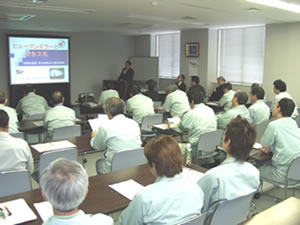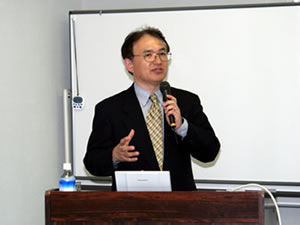
|
|
During the safety presentation
|
Hitachi Zosen Mechanical Corporation's 26 employees attended the safety presentation.
The session started with an opening address by Hitachi Zosen Mechanical's director and Nuclear Development Office manager Ryoji Asano. He said, "This is the third safety caravan at our site, with the previous one conducted in 2002. Being a manufacturer of large machinery including nuclear casks, safety is our top-priority theme. This year marks the 20th anniversary of the Chernobyl disaster, a time for refreshing our acknowledgement on the importance of nuclear safety. I wish to express our gratitude for being given the opportunity, at a perfect time like this, for renewing our commitment to safety and receiving valuable advice on our safety activities through the Safety Presentation by Mr. Matsuo in the morning and the Safety Information Exchange Session in afternoon. Thank you in advance for a full day of information and guidance." |

|
|
Mr. Takashi Matsuo
|
Lecture highlights
○Why do human errors occur?
Humans are a type of animal that survives through accommodating elements in the real world. History of human evolution indicates that we humans did not live in an environment that required delicate accuracy, and therefore prioritized efficiency over accuracy. We are, by nature, incapable of behaving or making decisions accurately and logically. Making errors (human errors) represents one of the basic human characteristics.
Human errors became a problem (1) when humans began to operate tools and machines involving a large amount of energy, and (2) when the distribution of labor started to hinder conveyance of information. In other words, it is essentially the problem of information-conveying mechanisms and materials we handle, rather than the problem of individual human beings.
○Measures for preventing human errors
Prevention of human error requires the "error-resistant" approach of reducing the number of errors themselves, and the "error-tolerant" approach of preventing errors from evolving into an accident. For error reduction, it is necessary to reduce operation opportunities, make each operation easy to understand and share relevant information. To prevent errors from turning into an accident, it is important to build a mechanism that provides external clues to draw people's attention to errors. External clues have the elements of target, display, document and humans, and the usability and achievability of all of these elements must be taken into consideration in building a safety system.
Individual workers must improve their work skills, risk awareness and expert knowledge, while also sharing consensus on what understanding should be established to build a safety culture.
○Establishing a safety culture
Organizational initiatives must be implemented to establish a safety culture. Since the behavior of individual workers depend largely on their personal vested interest, safety-oriented actions are perceived as a "cost", and are not implemented indefinitely even if there is a call for greater awareness. An organization must form social rules for safety-oriented behavior. Yet, the presence of exceptional rules and excessive costs for compliance would make the state of "non-compliance" a norm in the organization.
Lessons learned from accidents and near-miss incidents must be reflected when building a system of nuclear safety. Problems must be resolved NOT through punishing or dismissing parties involved in an accident, but through clarifying the cause of the accident, seeking to prevent future accidents and learning from past accidents. Indeed, public interest must be secured through indemnifying involved parties, identifying the cause of the accident and preventing massive potential damage that could come about in the future.
The following comments were given in the survey conducted after the presentation.
○The assertion that "humans are, by nature, incapable of correct judgments and behavior", was refreshingly unique. We should employ this perspective in reviewing our company's "Management Code", which may have become nothing more than a descriptive set of rules.
○What caught my attention was the parts where he said that (1) it has only been the last 100 years of human history that the mankind needed to exercise logic, and that (2) we must work on the premise that humans make errors. I sensed the need to improve "materials" and re-evaluate "errors".
○I have always pondered what we can do to prevent careless mistakes. I have implemented the concept of "classical spiritualism", mentioned in today's presentation, in many instances, but have yet to find an innovative methodology. I will make use of some inspirations I gained in the presentation. |







